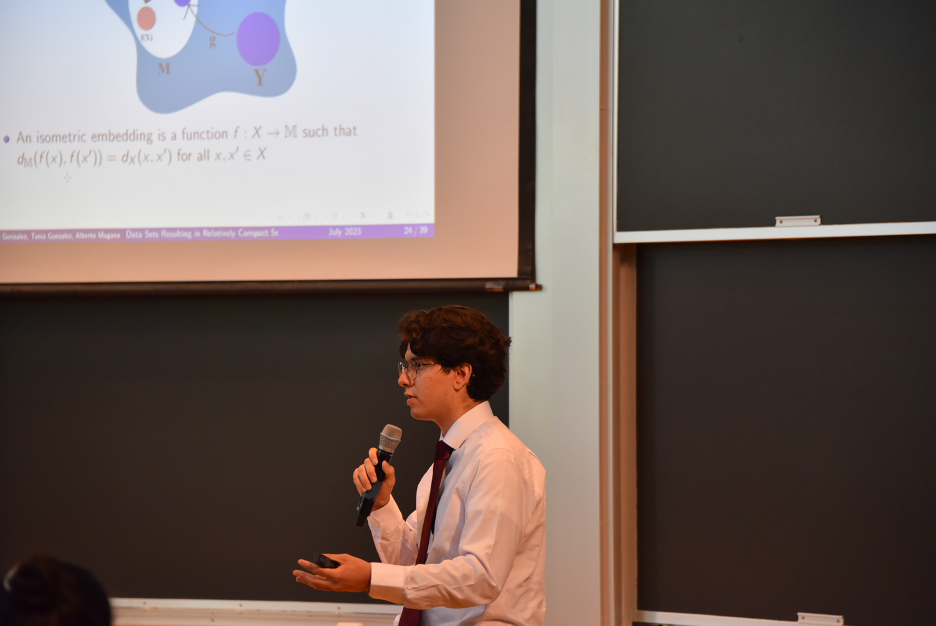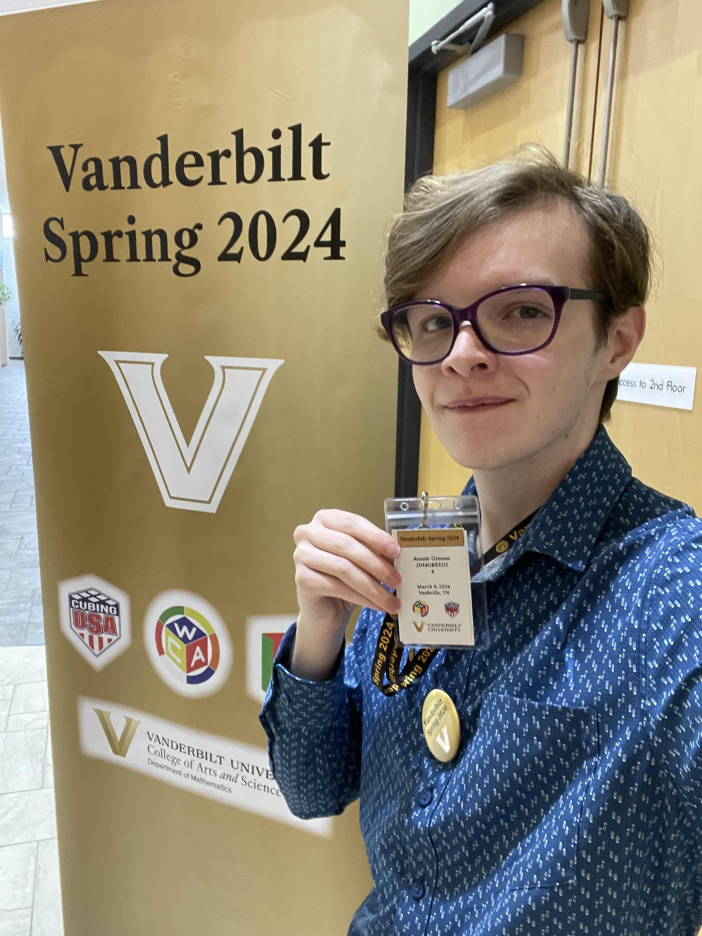Immersion
Immersion Vanderbilt Is… a graduation requirement for all undergraduates, including transfer students, and an exciting opportunity to customize your education. In the Department of Mathematics, we see it as a chance for you to explore mathematics beyond the classroom and create something meaningful.
Whether you’re passionate about theoretical research, teaching and outreach, or applying math to real-world problems, Immersion Vanderbilt can help you go deeper and make your work count.
How It Works
Immersion Vanderbilt consists of two main parts:
1. The Immersive Experience
Choose a substantial experience that allows you to explore a topic deeply over time. You may select from six general pathways listed by the university: Explore all immersive pathways
Math majors often pursue immersive experiences like:
- Mathematics Research
Join a research project under the guidance of a faculty mentor. Opportunities include:- Vanderbilt-funded summer research or independent study
- National REUs (research experience for undergraduates)
- Study Abroad
Participate in a pre-approved Vanderbilt study abroad program with a math focus.- Budapest Semesters in Mathematics: https://budapestsemesters.com/
- Internships and Industry Experiences
Apply mathematics in data science, finance, tech, education, and more. - Community Engagement and Teaching
Help lead local outreach programs such as the Vanderbilt Math Circle, or design your own civic engagement project using math.
Note: your immersive experience does not need to relate to your major.
2. The Culminating Project
This is what you create as a result of your immersive experience. It should synthesize what you’ve learned and allow you to share your work with others. Possibilities include:
- Writing a research paper
- Presenting at the Vanderbilt Undergraduate Research Fair
- Creating your own Math Circle materials and leading a Math Circle
- Completing a creative project, blog, YouTube video, or portfolio
When you’re ready, submit your work through the Culminating Project Submission Form. Your faculty advisor will review and approve your submission.
span style=”font-size: 120%;”
Timeline and Advising
- When to Start: It’s never too early to start planning your immersion. We recommend identifying an immersive experience by your sophomore year.
- Before You Graduate: You must invite a faculty advisor to oversee your culminating project by the end of your final semester.
If you’re not sure where to start, talk with your math major advisor or schedule an Immersion Vanderbilt advising appointment:
Immersion Office Location: E. Bronson Ingram College, Room 1003
Office Hours: Monday–Friday, 8:00 AM – 5:00 PM
Appointments: In-person, virtual, or by phone
Book an appointment via Handshake
Recent Examples
Alberto MagaÑa
 Alberto Magana attended a summer research experience at the Mathematical Sciences Research Institute (MSRI), and worked on a project involving curve lifting and the virtual braid group, a rich mathematical structure with connections to topology and algebra. Magana’s work focused on the topological perspective, investigating the spaces on which the group acts and the implications of those actions. Alberto says the experience deepened his understanding of what mathematical research entails: “It showed me what research in this field is really like.” He emphasized the importance of his Vanderbilt coursework in topology and abstract algebra, stating, “The concepts and techniques I learned in those classes were essential to my research.” His immersion project helped confirm his plans to pursue a PhD in mathematics, likely in topology or geometry. Alberto’s final culminating project was an expository paper summarizing what he had read and discussing some related problems.
Alberto Magana attended a summer research experience at the Mathematical Sciences Research Institute (MSRI), and worked on a project involving curve lifting and the virtual braid group, a rich mathematical structure with connections to topology and algebra. Magana’s work focused on the topological perspective, investigating the spaces on which the group acts and the implications of those actions. Alberto says the experience deepened his understanding of what mathematical research entails: “It showed me what research in this field is really like.” He emphasized the importance of his Vanderbilt coursework in topology and abstract algebra, stating, “The concepts and techniques I learned in those classes were essential to my research.” His immersion project helped confirm his plans to pursue a PhD in mathematics, likely in topology or geometry. Alberto’s final culminating project was an expository paper summarizing what he had read and discussing some related problems.
Aussie Green
 Aussie Greene spent two years working with Dr. Larry Schumaker on numerical methods for solving partial differential equations (PDEs) using multivariate spline functions. His work focused on applying these techniques to complex, three-dimensional domains—an area with potential applications in fields like engineering and medical imaging. “Spline functions, which are piecewise polynomial functions, are especially helpful tools in the field of approximation theory,” Aussie explains. “They can fit real world data with specified degrees of smoothness and great computational efficiency.” Aussie’s immersion culminated in a detailed paper titled Numerical Methods for Solving Partial Differential Equations on Complicated Non-Convex 3D Domains using Multivariate Spline Functions, which formed the basis of a talk he gave at the Constructive Functions 2025 conference and a manuscript now under review. “A big component of my research regards the `mesh generation problem,’ which involves taking complex continuous domains and simplifying them into discrete shapes that are compatible with our numerical methods. Other than the two courses that directly prepared me for my current research—MATH 3620 (Numerical Analysis) and MATH 3890 (Computing with Splines)—I use the tools and intuition I developed in my linear algebra classes (MATH 2500, 2501, 3330) every day when developing software.” Aussie plans to pursue a PhD in computational mathematics, with a long-term goal of developing tools for fields like oncology and imaging.
Aussie Greene spent two years working with Dr. Larry Schumaker on numerical methods for solving partial differential equations (PDEs) using multivariate spline functions. His work focused on applying these techniques to complex, three-dimensional domains—an area with potential applications in fields like engineering and medical imaging. “Spline functions, which are piecewise polynomial functions, are especially helpful tools in the field of approximation theory,” Aussie explains. “They can fit real world data with specified degrees of smoothness and great computational efficiency.” Aussie’s immersion culminated in a detailed paper titled Numerical Methods for Solving Partial Differential Equations on Complicated Non-Convex 3D Domains using Multivariate Spline Functions, which formed the basis of a talk he gave at the Constructive Functions 2025 conference and a manuscript now under review. “A big component of my research regards the `mesh generation problem,’ which involves taking complex continuous domains and simplifying them into discrete shapes that are compatible with our numerical methods. Other than the two courses that directly prepared me for my current research—MATH 3620 (Numerical Analysis) and MATH 3890 (Computing with Splines)—I use the tools and intuition I developed in my linear algebra classes (MATH 2500, 2501, 3330) every day when developing software.” Aussie plans to pursue a PhD in computational mathematics, with a long-term goal of developing tools for fields like oncology and imaging.
For Transfer Students
Transfer students are also required to complete Immersion Vanderbilt. You may be able to count previous experiences toward the immersive experience. Meet with an Immersion advisor to discuss your options.
Questions?
Wondering whether your idea fits or want help brainstorming? Contact your academic advisor, the Mathematics Department Director of Undergraduate Studies, or reach out to the Immersion team directly. The Department of Mathematics is excited to help you design a project that aligns with your interests and makes your time at Vanderbilt truly immersive.
